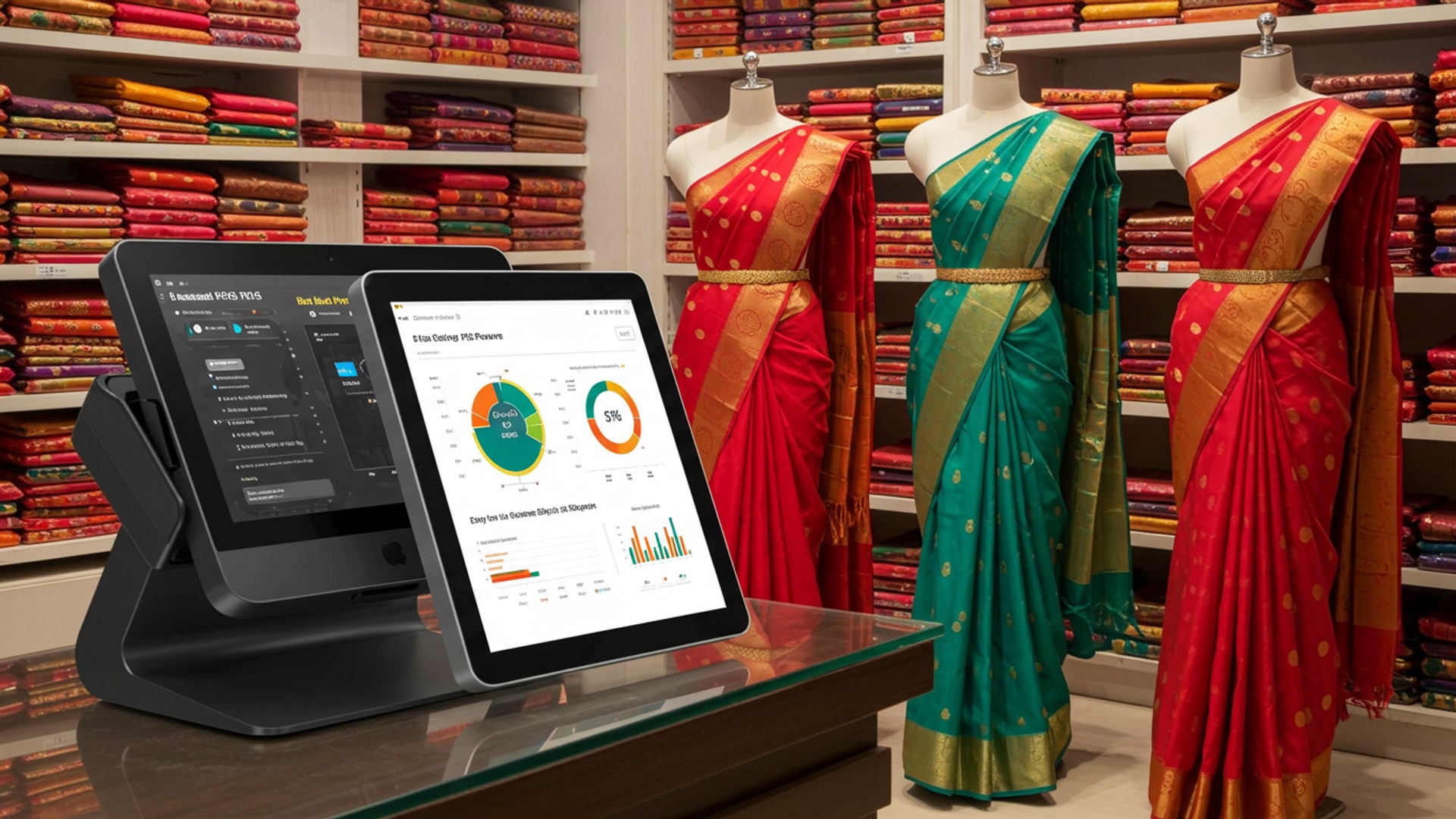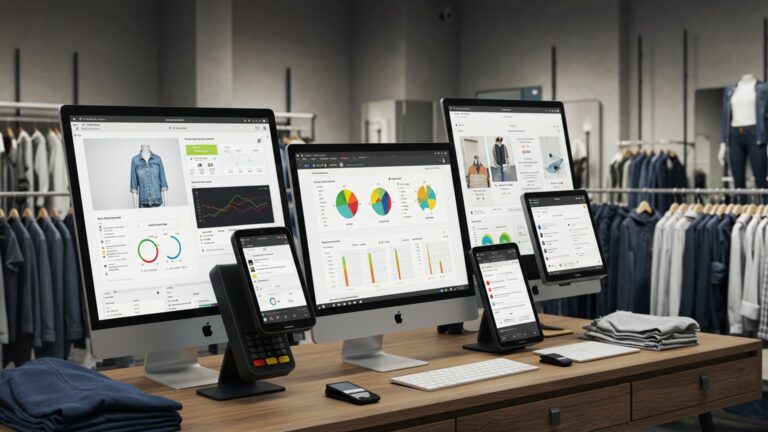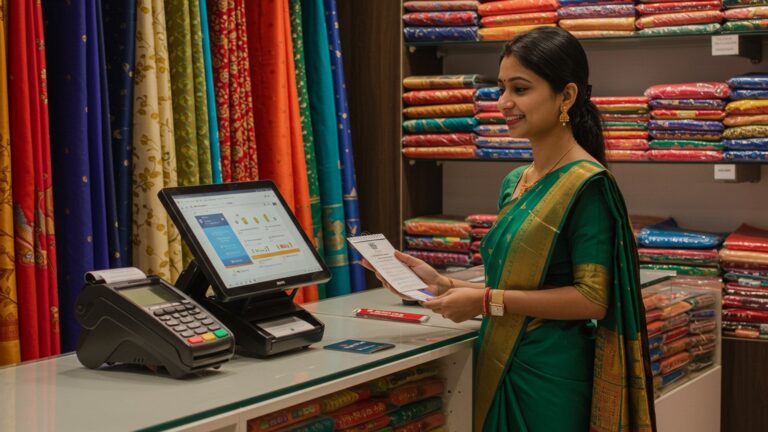5 Essential POS System Features Every Saree Shop Needs to Boost Sales
In the vibrant, competitive world of saree retail, simply offering exquisite weaves is no longer enough; operational excellence, driven by smart technology, is paramount. Modern saree shops, navigating a market increasingly defined by online trends and discerning customers, require a robust pos system for saree shop that goes far beyond basic transaction processing. Imagine effortlessly managing thousands of unique SKUs, from Banarasi silk to Kalamkari cotton, tracking intricate karigari work, or instantly identifying customer preferences for specific designers. A truly effective system empowers shop owners to not only streamline sales but also to harness real-time data for inventory optimization, personalize customer engagement through targeted promotions. integrate seamlessly with digital payment gateways, ensuring every drape sold contributes to a smarter, more profitable business model.

1. Advanced Inventory Management with Variant Tracking
For any saree shop, managing inventory is far more complex than just counting items. Sarees come in a myriad of fabrics, weaves, designs, colors. even specific regional origins. A single design might be available in multiple color variations or fabric blends. This complexity necessitates an advanced inventory management system within your pos system for saree shop.
What it is:
Advanced inventory management allows you to track not just the quantity of each saree. also its specific attributes or “variants.” For example, if you stock a Kanjivaram silk saree, the system can differentiate between a red Kanjivaram, a blue Kanjivaram, or one with a peacock motif versus a floral motif, all under the same product family.
Why it’s essential for a Saree Shop:
- Prevent Stockouts and Overstocking
- Accurate Product Categorization
- Simplified Returns and Exchanges
Imagine a customer walks in asking for a specific Banarasi saree they saw online. With a robust POS, you can instantly check if that exact variant (e. g. , “Banarasi Silk – Peacock Blue – Gold Zari”) is in stock, at which location. how many pieces are available. This prevents lost sales due to unknown stock levels or tying up capital in slow-moving inventory.
It allows for meticulous organization by fabric (e. g. , “Silk,” “Cotton,” “Georgette”), weave (e. g. , “Kanjivaram,” “Paithani,” “Chiffon”), design patterns. even price tiers. This makes it easier for staff to locate items and for customers to browse.
When a customer returns a saree, the system can quickly verify the exact item, its purchase date. condition, streamlining the process and maintaining accurate inventory counts.
How it boosts sales:
By providing real-time, granular data on every saree variant, staff can confidently upsell and cross-sell. If a customer is looking for a red silk saree that’s out of stock, the system can immediately suggest similar alternatives or even show what’s available at another branch. This proactive approach ensures fewer missed sales opportunities and a more satisfying customer experience. Consider a scenario where a shop owner, Ms. Priya, used to spend hours manually tracking her unique silk saree collection. After implementing a pos system for saree shop with variant tracking, she now knows exactly which colors of her popular Mysore Silk sarees are selling fast and can reorder them proactively, avoiding disappointed customers.
2. Integrated Customer Relationship Management (CRM)
In the world of saree retail, personal connections and understanding customer preferences are paramount. An integrated CRM feature within your pos system for saree shop transforms transactional data into valuable insights, enabling personalized service that fosters loyalty.
What it is:
An integrated CRM module captures and stores customer insights, purchase history, preferences, contact details. even special notes (e. g. , “prefers handloom sarees,” “bought a bridal saree last year”). This data is directly linked to their transactions at the point of sale.
Why it’s essential for a Saree Shop:
- Personalized Recommendations
- Targeted Marketing
- Enhanced Customer Service
Imagine remembering that a customer purchased a specific type of Kanjivaram for a wedding last year. With CRM, your staff can recall this, greet them by name. suggest new arrivals in similar styles or complementary accessories for their next occasion.
Instead of generic promotions, you can segment your customer base. Send an exclusive preview of new Tussar silk collections to customers who have previously purchased Tussar, or offer a birthday discount to loyal patrons.
When a customer has a query or a return, their entire purchase history is immediately accessible, allowing for faster, more informed assistance.
How it boosts sales:
Personalization drives repeat business. When customers feel understood and valued, they are more likely to return and become loyal advocates. A pos system for saree shop with robust CRM helps you build lasting relationships. For example, a customer who bought an expensive bridal saree might appreciate a follow-up email a few months later showcasing new festive wear collections. This kind of targeted engagement significantly increases the chances of a subsequent purchase, converting one-time buyers into lifelong customers. Mr. Rajesh, who owns a boutique saree store, noted a 15% increase in repeat customer purchases within six months of leveraging his POS system’s CRM for personalized outreach and recommendations.
3. Robust Sales Analytics and Reporting
Understanding what sells, when it sells. who buys it is critical for strategic decision-making in any retail business, especially a saree shop with its diverse inventory. A pos system for saree shop with powerful analytics capabilities can turn raw sales data into actionable insights.
What it is:
Sales analytics and reporting features collect all transaction data and present it in easily digestible reports and dashboards. This includes sales by product, category, time period, staff member, customer segment. even specific saree variants. It can track average transaction value, peak sales hours. best-selling designs.
Why it’s essential for a Saree Shop:
- Identify Best-Sellers and Slow-Movers
- Optimize Inventory Purchasing
- Evaluate Staff Performance
- Strategic Pricing and Promotions
Pinpoint which types of sarees (e. g. , “Chanderi cottons,” “Patola silks”) are your top performers and which are tying up capital on the shelves.
Armed with data, you can make informed decisions on what to reorder, in what quantities. from which suppliers. This prevents overstocking unpopular designs and ensures popular ones are always available.
Track individual sales performance, identify training needs. incentivize top-performing sales associates.
interpret the impact of discounts and promotions on specific saree categories, allowing you to fine-tune future marketing efforts.
How it boosts sales:
Data-driven decisions lead to optimized inventory, effective marketing. improved profitability. By knowing your sales trends, you can stock the right sarees at the right time, catering precisely to customer demand. For instance, if reports show a surge in demand for lightweight, contemporary sarees during festival seasons, you can adjust your procurement and marketing strategies accordingly. This ensures your capital is invested wisely and your shop is always offering what customers want, directly translating to increased sales. Consider how a pos system for saree shop helped Mrs. Sharma, who discovered through analytics that her traditional silk sarees sold best during specific regional wedding seasons, allowing her to ramp up stock and marketing before these periods, leading to a 20% sales increase in those months.
4. Seamless Barcode Scanning & Quick Checkout
In a bustling saree shop, especially during festive seasons, customer experience at the checkout counter can significantly impact satisfaction and even repeat business. Slow or error-prone transactions can lead to frustration. A modern pos system for saree shop with seamless barcode scanning and quick checkout capabilities is crucial for efficiency.
What it is:
This feature involves using barcode scanners to quickly and accurately identify sarees, retrieve their prices and details. process sales transactions efficiently. It supports various payment methods (cash, card, UPI, digital wallets) and generates professional receipts.
Why it’s essential for a Saree Shop:
- Speed and Efficiency
- Accuracy
- Professional Customer Experience
- Real-time Inventory Updates
Manual entry of saree codes or prices is time-consuming and prone to errors. Barcode scanning ensures rapid and accurate data input, significantly speeding up the checkout process.
Eliminates human error in pricing and item identification. Each saree has a unique barcode linked to its exact variant and price in the system.
A smooth, quick checkout leaves a positive lasting impression, enhancing overall customer satisfaction.
Every scanned sale instantly updates your inventory, providing the most accurate stock levels for all saree variants.
How it boosts sales:
Faster checkout means shorter queues, especially during peak hours, preventing potential customers from abandoning their purchases due to long waits. A streamlined process reflects professionalism and efficiency, making customers more likely to return. Moreover, accurate pricing builds trust. When a customer knows they are being charged correctly and efficiently, their shopping experience is elevated, encouraging repeat visits. For example, during Diwali, when a pos system for saree shop like ‘Saree Emporium’ processes hundreds of transactions, the ability to scan barcodes and complete sales in seconds ensures that no customer walks away frustrated by delays. This efficiency directly contributes to higher transaction volumes and happier customers, fueling sales growth.
Example of a quick checkout process: 1. Customer brings chosen saree to counter. 2. Staff scans saree barcode. 3. POS system instantly displays saree details (name, variant, price). 4. Staff adds any accessories (blouse piece, petticoat) by scanning or quick selection. 5. Customer chooses payment method (e. g. , UPI). 6. Staff processes payment. 7. Receipt printed/emailed instantly. 8. Inventory updated in real-time.
5. Loyalty Programs & Promotions Management
Cultivating customer loyalty is a cornerstone of sustained success for any saree shop. A pos system for saree shop that includes robust loyalty programs and promotions management features can turn casual buyers into devoted patrons, significantly boosting long-term sales.
What it is:
This feature allows you to design, implement. manage various customer loyalty programs (e. g. , points-based systems, tiered memberships) and promotional campaigns (e. g. , “Buy One Get One,” percentage discounts, festive offers). It tracks customer participation and applies discounts automatically at the point of sale.
Why it’s essential for a Saree Shop:
- Encourage Repeat Purchases
- Drive Higher Average Transaction Value
- Attract New Customers
- Data-Driven Promotions
Loyalty programs incentivize customers to return to your shop to earn and redeem rewards, rather than exploring competitors.
Customers might purchase an additional saree or accessory to reach a higher reward tier or qualify for a special discount.
Well-advertised promotions can draw in new clientele, especially during sales events or festive seasons.
Integrate with CRM and sales analytics to create targeted promotions based on past purchase behavior, ensuring higher conversion rates.
How it boosts sales:
Loyalty programs directly increase customer lifetime value by fostering a sense of appreciation and offering tangible benefits for continued patronage. Promotions, when strategically deployed (e. g. , a “monsoon sale” on silk-cotton blends), can clear old stock, drive impulse purchases. generate buzz. Imagine a customer, Mrs. Kapoor, who has accumulated points on her previous saree purchases. When she receives a notification from her preferred pos system for saree shop about a new collection launch and an offer to redeem her points for a discount, she’s highly likely to visit and make another purchase. This direct incentive, coupled with personalized communication, creates a powerful sales-driving mechanism. A study by Accenture found that 79% of consumers are more likely to make a purchase from a brand that offers loyalty programs.
| Feature Type | Example Promotion | How it Boosts Sales |
|---|---|---|
| Points-Based Loyalty | Earn 1 point for every ₹100 spent, redeem 500 points for ₹500 off. | Encourages repeat visits to accumulate and redeem points. |
| Tiered Membership | Silver (₹10k spend), Gold (₹25k spend) with increasing discounts. | Motivates higher spending to unlock better benefits. |
| Bundle Offer | Buy any two festive sarees, get a matching blouse piece 50% off. | Increases average transaction value by encouraging add-on purchases. |
| Seasonal Discount | 20% off on selected traditional sarees during Wedding Season. | Drives traffic and clears specific inventory during relevant periods. |
Conclusion
Embracing the right POS system is no longer a luxury but a strategic necessity for any saree shop aiming to thrive in today’s dynamic retail landscape. We’ve seen how features like robust inventory management, especially for diverse silk varieties or intricate weaves, can streamline operations, while integrated CRM helps recall a customer’s preference for Kanjeevarams or Banarasis, leading to truly personalized experiences. My personal tip? Don’t just pick a system with the most features; choose one that genuinely understands the unique rhythm and inventory nuances of a saree business. Consider how a modern POS, with its data analytics capabilities, can reveal popular trends during festive seasons or highlight underperforming stock, much like how a seasoned salesperson understands their clientele. This shift from manual processes to data-driven insights is a current trend transforming traditional retail. I recall a boutique in Chennai that, after upgrading its POS, saw a 20% increase in repeat customers by simply leveraging purchase history for targeted promotions. Ultimately, a well-chosen POS is your silent partner, ensuring every exquisite drape finds its perfect owner efficiently. Invest wisely. watch your saree shop not just survive. elegantly flourish.
More Articles
Learn 6 Smart Clothing Store POS Software Strategies for India
Learn How to Select the Right POS Software for Your Business Success
7 Essential Inventory Management POS Strategies for Indian Businesses
Mastering Textile Retail 8 Must-Have POS Software Features
How to Choose the Best Billing and POS Software for Your Business
FAQs
Why bother with a POS system for my saree shop? Isn’t a cash register enough?
A modern POS system is way more than just a cash register. It helps you track every unique saree, grasp your customers better, speed up checkouts. gives you insights into what’s selling well. All this makes your operations smoother and directly helps you sell more, unlike a basic cash register.
How can a POS system help me keep track of all my different sarees and their stock?
With advanced inventory management, you can log every single saree – its design, fabric, color, size. even unique IDs. This means you always know exactly what’s in stock, what’s selling fast. what you need to reorder. No more lost sales from empty shelves or overstocking on less popular items.
Can a POS help me remember my customers’ preferences and make them feel special?
Absolutely! A good POS includes CRM (Customer Relationship Management) features that let you record customer purchase history, contact details. even notes on their style preferences. This allows you to offer personalized recommendations, send targeted promotions. run loyalty programs, making customers feel valued and encouraging repeat business.
What kind of sales details can a POS give me to boost my saree sales?
You’ll get detailed reports on your best-selling sarees, peak sales times, average transaction value. even individual staff performance. This data helps you make smarter decisions about stocking, marketing. staffing, leading to more effective sales strategies and a better understanding of what your customers truly want.
Does a POS system make the checkout process quicker and more convenient for my saree buyers?
Yes, definitely. An integrated POS system supports various payment methods like credit cards, debit cards. mobile payments, all processed quickly and securely. This smooth and efficient checkout experience is a big plus for customer satisfaction and reduces waiting times, especially during busy periods.
How does a POS make handling returns or exchanges less of a headache?
A good POS system streamlines the entire return and exchange process. It allows you to quickly look up purchase records, verify items. process refunds or swaps accurately. This efficiency not only saves time for you and your staff but also keeps your customers happy, even if they’re returning something.
So, summing it up, how do all these POS features actually help my saree shop sell more?
By giving you better control over inventory, deeper insights into customer behavior and sales trends, faster transactions. smoother operations, a POS system essentially frees you up to focus on selling. It helps you stock the right sarees, target the right customers. provide an excellent shopping experience, all of which directly contribute to higher sales and a more profitable business.






